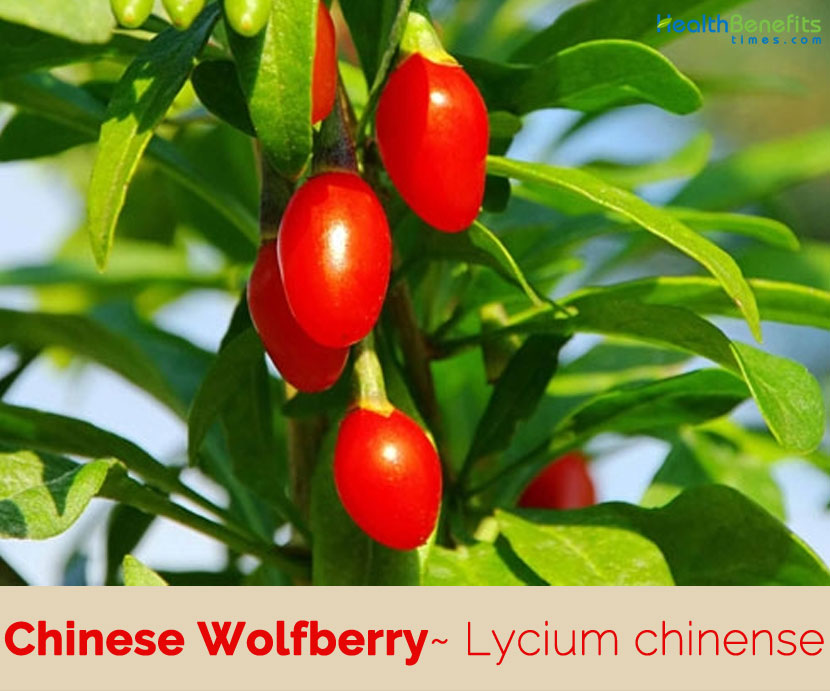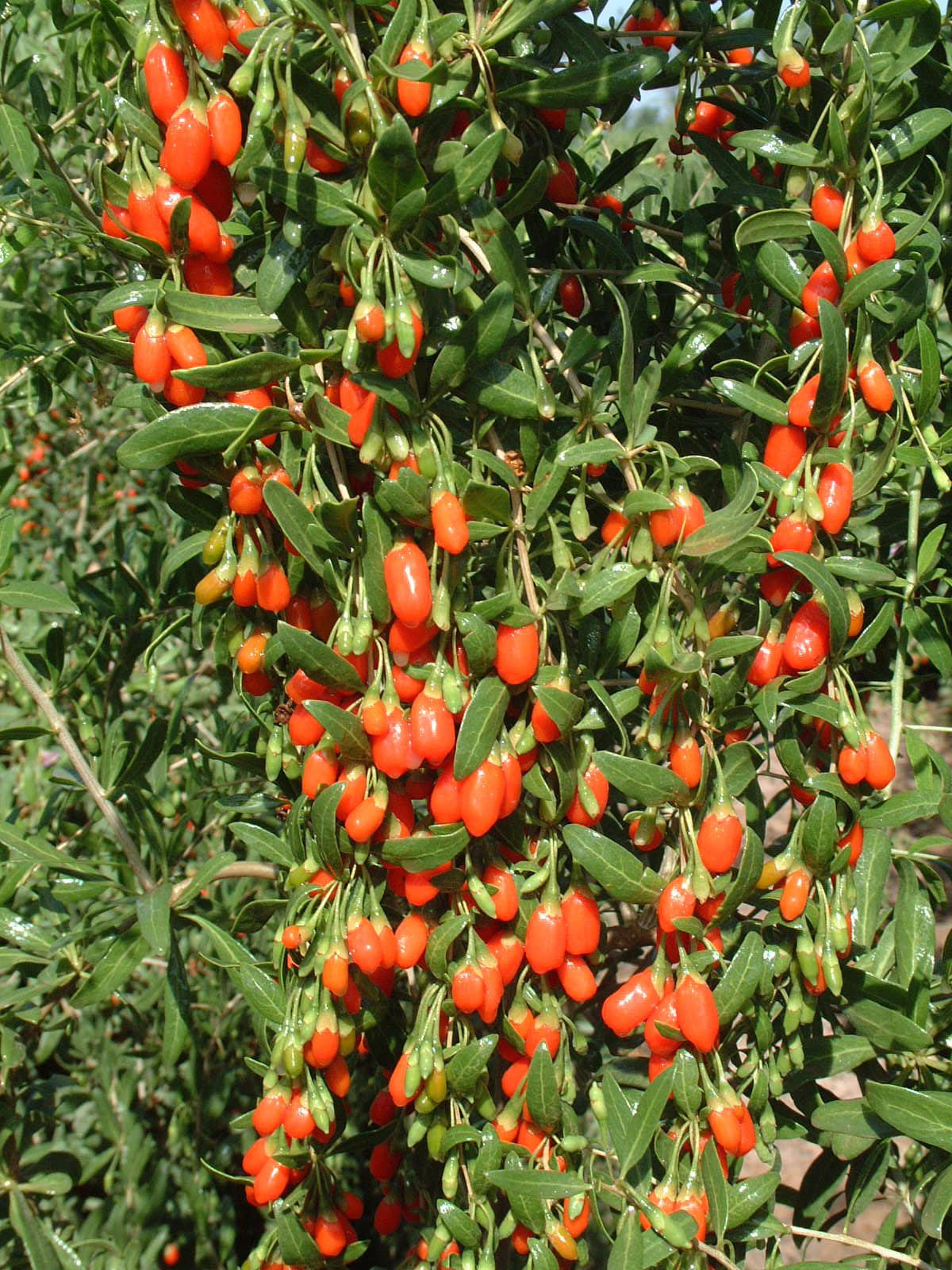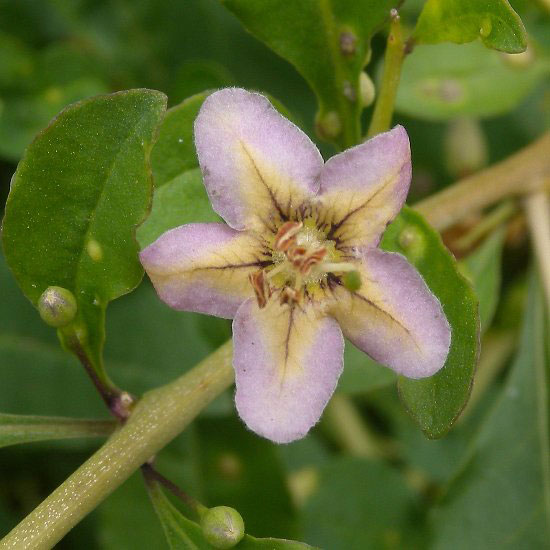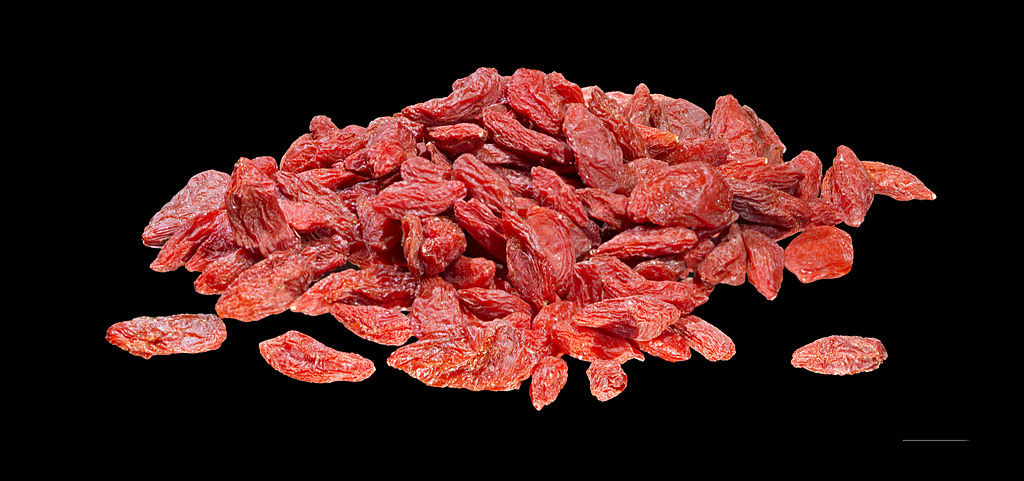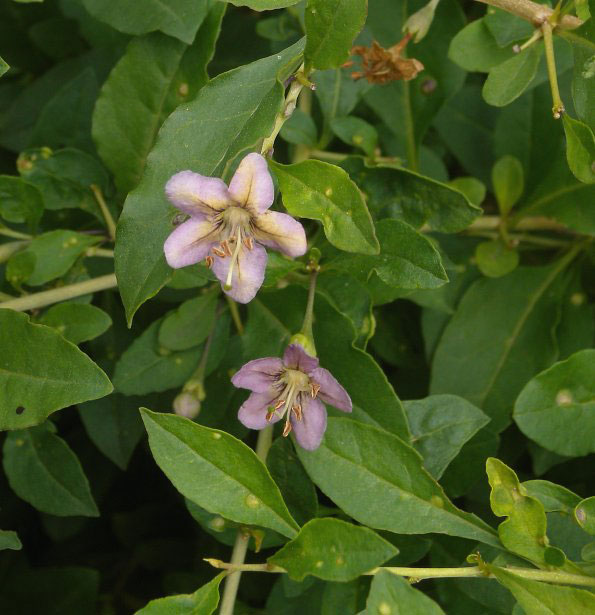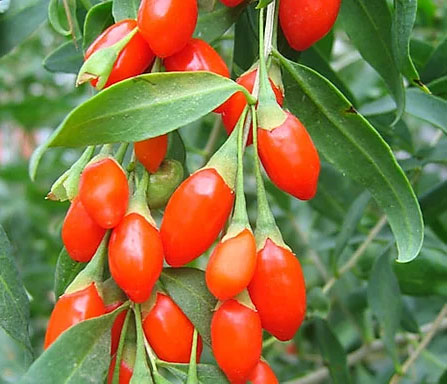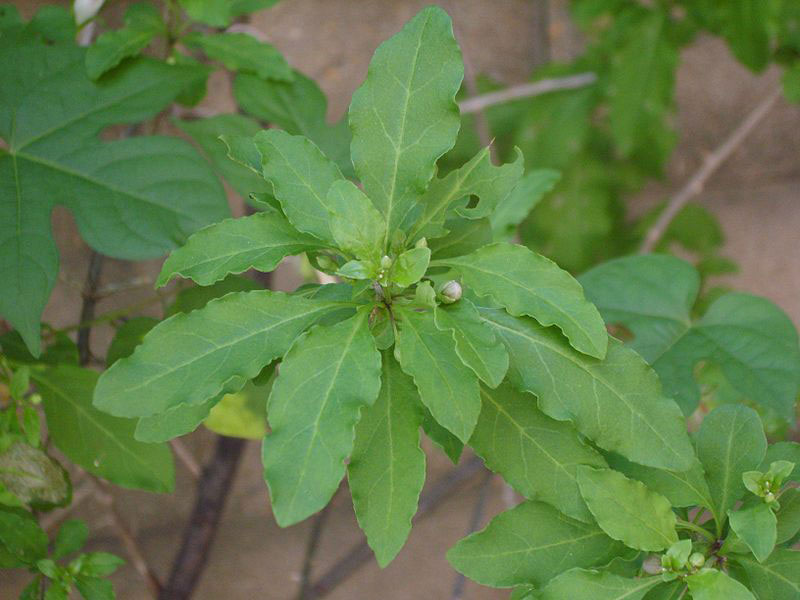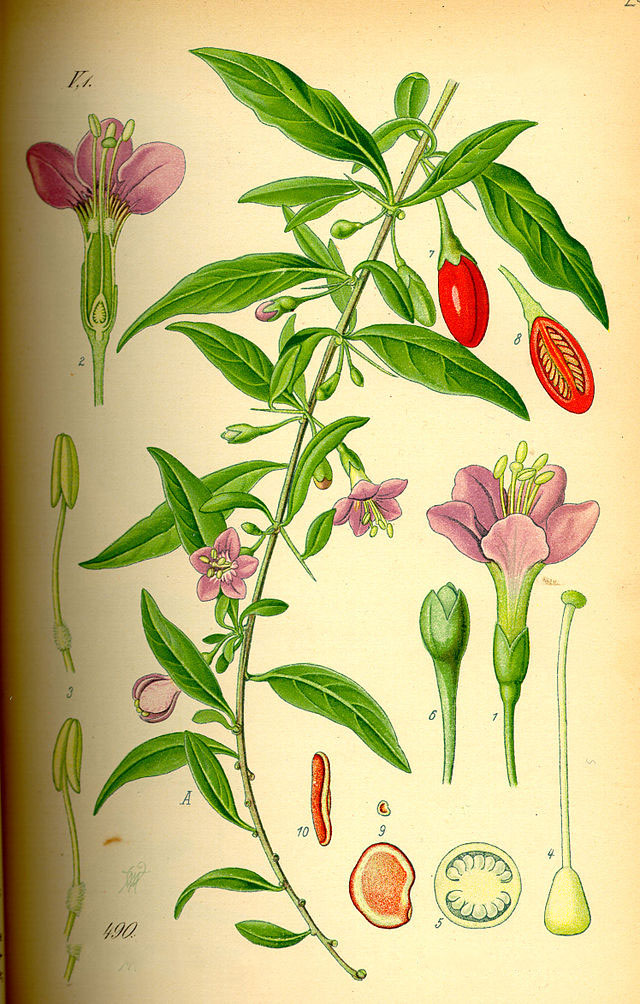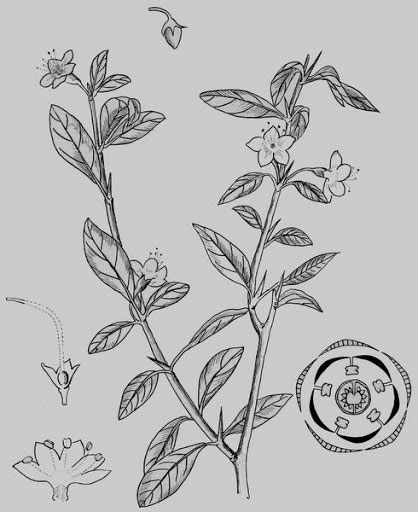Genus name comes from the Greek name for a thorny tree from Lycia, a south-west region of Asia Minor that was used medicinally. Specific epithet means Chinese. Traditionally it is supposed to promote long life —a Chinese herbalist said to have lived for 252 years ascribed his longevity to tonic herbs, including lycium. Today both the berries and the root have a wide range of medicinal uses. The root can be unearthed at any time of the year but is most commonly harvested in spring. The berries are picked in late summer or early autumn.
Chinese Wolfberry Facts
| Chinese Wolfberry Quick Facts | |
|---|---|
| Name: | Chinese Wolfberry |
| Scientific Name: | Lycium chinense |
| Origin | China, Taiwan and Japan and widely cultivated in South east and north Asia |
| Colors | Red or orange-red |
| Shapes | Ovoid or ellipsoid berry, 0.7–1.5 cm × 5–8 mm |
| Flesh colors | Reddish |
| Taste | Sweet, Pungent, Astringent |
| Health benefits | Boosts the Immune System, Heart Health, Increases Testosterone, Protect from Cancer, Restores Glutathione, Detoxifies Your Body, Improve Mood, Promotes Skin Health, Helps Weight Loss, Liver Health, Anti-aging, Improves Vision, Cooling properties |
| Name | Chinese Wolfberry |
|---|---|
| Scientific Name | Lycium chinense |
| Native | China (Anhui, Fujian, Gansu, Guangdong, Guangxi, Guizhou, Hainan, Hebei, Heilongjiang, Henan, Hubei, Hunan, Jiangsu, Jiangxi, Jilin, Liaoning, Nei Mongol, Ningxia, Qinghai, Shaanxi, Shanxi, Sichuan, Yunnan, Zhejiang), Taiwan and Japan and widely cultivated in South east and north Asia. Wolfberry is also naturalized in Europe, eastern United States, Japan, Korea, Mongolia, Nepal, Pakistan and south-west Asia |
| Common Names | Common Boxthorn, Chinese Boxthorn, Chinese Desert-Thorn, Chinese Tea Plant, Chinese Wolfberry, Duke Of Argyll Tea Tree, Goji Berry, Go Qi Zi, Gow Kee, Matrimony Vine, Wolfberry, Daun koki, Gau gei choi, Gouqi, Gugijanamu, Holly Willow, Kaokichai, Kaukichai, Kaukichoy, Kei-chi, Kou-chi, Kou-kay-choi, Kuko |
| Name in Other Languages | Armenian: Hazaz ch’inakan (Հազազ չինական) Chinese: Gou qi (枸杞), Dì Gǔ Pí, Gǒuqǐ, Gǒu Qǐ Zǐ, Kei-Chi, Kau Kei Croatian: Vučac Czech: Kustovnice čínská, Kustovnica Danish: Bredbladet bukketorn Dutch: Gaugee, Daoon koki, Chinese boksdoorn English: Chinese boxthorn, Chinese desert-thorn, Chinese matrimony-vine, Chinese tea plant, Chinese wolfberry, chinese tea-tree, wolfberry, gow kee Finnish: Kiinanpukinpensas French: Lyciet de Chine, Lyciet German: Bocksdornbeere, Chinesischer Bocksdorn Greek: Lýkeio to sinikó (Λύκιο το σινικό) Hungarian: Kínai ördögcérna Icelandic: Kinafletta Indonesian: Daun koki Italian: Spina santa cinese, licio della Cina Japanese: Kuko (クコ), Kuko (くこ), Kuko no mi (クコの実) , Kuko no kajitsu (クコの果実), Kukoshi (クコ) Korean: Gu gi ja (구기자), Gu gi ja na mu (구기자나무), Bulro Kugi, Kukija, Kujijanamu Malay: Kaukichai, Kaukichoy, Keichi Malayan: Kaukichai Norwegian: Kinabukketorn Persian: لیسیوم چینی Polish: Kolcowój chiński Portuguese: Cambroeira-da-china Romanian: Goji Russian: Dereza kitayskaya (Дереза китайская), Derezy plod (Дерезы плод), Kitayskaya zamanikha (Китайская заманиха), Koz’ye moloko (Козье молоко), Volch’ya yagoda (Волчья ягода) Slovak: Kustovnica čínska Spanish: Cambrona de Ningxia, Cambronero chino Swedish: Bredbladigt bocktörne Thai: Keā kī c̄h̀ā y (เกากีฉ่าย) , Găo Gèe, Kaokichai, Kaochichai Tibetan: Dretsherma, Dretshermǟ Dräwu Turkish: Termiye çalısı Vietnam : Cẩu Kỷ, Cẩu Kỷ Tử, Củ Khởi, Rau Khoi, Khu Khoi, Dia Coy Bi, Khoi Tu, Kỷ Tử, Phjac Khau Khi ( Tay ) Welsh: Ysbeinwydden Tsieina |
| Plant Growth Habit | Much-branched, erect, sprawling, deciduous, woody perennial shrub |
| Growing Climates | Slopes, wastelands, saline places, roadsides, near houses, thickets, river banks in lowland, thickets in lowland, house backyards, old homestead sites, areas along railroads and vacant lots |
| Soil | Grow in moderately fertile, medium moisture, well-drained soils |
| Plant Size | About 1–3 meters (3 ft. 3 in–9 ft. 10 in) high |
| Root | Woody and branching |
| Stem | Highly branched. Branches are pale gray, slender, curved or pendulous, with thorns 0.5–2 centimeters (0.20–0.79 in) long. |
| Leaf | Leaves distichous, bright green, with a short petiole; leaf-blade lanceolate to ovate, 1-14 cm × 0.5-6 cm, usually widest below the middle, the lower ones largest, margin entire. |
| Flowering season | June to August |
| Flower | Solitary or in few-flowered racemes, erect; calyx campanulate, 5-toothed, 3 mm long; corolla funnel-shaped, 5-lobed, 10-15 mm long, tube narrowly cylindrical at the base for 1.5 mm, lobes 5-8 mm long, red-purple with yellowish throat |
| Fruit Shape & Size | Ellipsoid berry, about 1 cm × 0.5-0.75 cm, red, many-seeded. |
| Fruit Color | Red or orange-red |
| Flesh Color | Reddish |
| Plant Parts Used | Ripe fruit, bark, leaves, flowers, Root bark |
| Seed | Seeds numerous, yellow, 2.5–3 mm with curved embryo |
| Taste | Sweet, Pungent, Astringent |
| Propagation | By seed or vegetatively propagated by hardwood cuttings |
| Lifespan | About 10 years |
| Season | August – November |
| Health Benefits |
|
Plant Description
Chinese wolfberry is a much-branched, erect, sprawling, deciduous, woody perennial shrub that normally grows about 1–3 meters (3 ft. 3 in–9 ft. 10 in) high. The plant is found growing in slopes, wastelands, saline places, roadsides, near houses, thickets, river banks in lowland, thickets in lowland, house backyards, old homestead sites, areas along railroads and vacant lots. The plant grows in moderately fertile, medium moisture and well-drained soils. Roots are woody and branching. Root is known to stimulate the parasympathetic nervous system, which controls involuntary bodily functions. It also relaxes the artery muscles, thus lowering blood pressure. Chinese research has shown the root to have a prominent ability to reduce fever, and in one clinical trial it had a significant effect in reducing fever in malaria.
Stem
Woody stems and shoots are ascending, arching, or sprawling, and they occasionally climb over nearby vegetation and objects like a vine. Older woody stems tend to be brown, terete, and thorny, while younger woody stems are light brown with whitish streaks, terete or 4-angled, and either thorn less or thorny. Thorns are up to ½ inch long or slightly longer. Young green shoots are light green, terete or 4-angled, hairless, and usually thorn less. Leaves occur along the young shoots or young woody stems; primary leaves are alternate, but secondary leaves occur in clusters from the axils of older primary leaves.
Leaves
Leaves form on the shoot either solitary in an alternating arrangement or in bundles of 2 to 4. Leaves may be ovate, rombic, lanceolate, or linear-lanceolate and toothless along their margins. They are usually 1.5–5 centimetres (0.59–1.97 in) long and 0.5–2.5 centimetres (0.20–0.98 in) wide (but up to 10 centimetres (3.9 in) long and 4 centimetres (1.6 in) wide in cultivated plants). Tips of these leaves are acute or blunt, while their bottoms taper into short petioles that are partially winged. Upper leaf surface is grayish green or medium green and hairless, while the lower leaf surface is pale grayish green or pale green and hairless.
Flower
Solitary or clusters of 2–3 flowers occur from the axils of leaves on hairless light green petioles 1–2 centimeters (0.39–0.79 in) long. Each flower is about ¾ inches long and similarly across, consisting of a bell-shaped (campanulate) light green calyx with 3–5 teeth, a lavender corolla with 5 spreading rounded lobes, 5 exserted stamens with brownish anthers, and an ovary with a single exserted white style that terminates in a swollen light green stigma. The base of each corolla is short tubular-funnel form; it is about the same length or a little shorter than its spreading lobes. The throat of the corolla and the interior of its lobes have dark pinnate and radiating veins, and sometimes the area around these veins is pale with light brown, yellowish, or greenish tints. Flowering normally takes place from June to August.
Fruit
If a shrub is fertile, the majority of the flowers will be replaced by orange-red to red berries that are 7–15 millimetres (0.28–0.59 in) long and 5 to 8 mm wide (but up to 22 millimetres (0.87 in) long and 10 millimetres (0.39 in) wide in cultivation). Fruits are long, ovoid or oblong in shape, hairless, and shiny. The interior of these berries is reddish and juicy. Each berry consists of about 10–20 seeds, however their number may varies widely based on cultivar and fruit size, from 10 to 60. Individual seeds are about 2.5 to 3 mm wide, orbicular-coiled in shape, somewhat flattened, and brownish yellow. The berries ripen from July to October in the Northern Hemisphere.
Berries (fresh or dried), young shoots and leaves are used in oriental cooking. Berries are used to make an herbal tea. Berries are dried for herbal use (China reportedly produces over 5 million kilograms of dried fruit per year). This is a long time medicinal plant (leaves, roots and berries) in China.
Health benefits of Chinese Wolfberry
Listed below are some of the popular health benefits of using Chinese wolfberry
1. Boosts the Immune System
Chinese wolfberry tea is considered a wonderful immune booster because it consists of fructose, which is good sugar. Since white sugar is bad for us fructose helps the function of our immune system and helps to keep our bodies strong and healthy, and fights off disease. Apart from that fructose found in goji berry tea also boosts our energy and helps us be more productive and perform better athletically.
2. Heart Health
Smoking, high cholesterol, high blood pressure, high levels of sugar in the blood, and blood vessel inflammation are the main causes of heart disease. Chinese wolfberry tea has the ability to lower cholesterol up to 70% and also reduces triglycerides. It protects against LDL, bad cholesterol, and prevents it from oxidizing. Drinking wolfberry tea can also reduce blood sugar levels and because it has anti-inflammatory properties, it can also reduce inflammation. All of that significantly lowers the risk of heart disease, making wolfberry tea an amazing natural medicine.
3. Increases Testosterone
Testosterone is a male sex hormone which has an important role in the male reproductive system. Chinese wolfberry tea helps to increases the levels of testosterone in a man’s body and thus increases the sperm count. It can also be very simulative for sexual desire and increases sexual performance. Chinese berries are a known aphrodisiac and have been used for hundreds of years in China. (+)
4. Protect from Cancer
Chinese wolfberry tea can protect you from cancer in several ways. First of all, wolfberry tea is an anti-oxidant which means it can prevent the oxidation of cells and decrease the risk of cancer. It also fights free radicals and prevents DNA damage that can be caused by them. And as it has already been said, wolfberry tea boosts the immune system which can also help to keep cancer away. (+)
5. Restores Glutathione
Glutathione is produced naturally by our liver and it is very important for our health. It is used for treating and preventing alcoholism, liver disease, heart disease, high cholesterol, among many others, and it also boosts the immune system. Chinese wolfberry tea can restore glutathione and keep the liver healthy.
6. Detoxifies Your Body
Chinese wolfberry tea is wonderful for detoxification and it is recommended to drink it in order to get rid of all the dangerous toxins from your body. Liver plays the key role in detoxing and Chinese wolfberry tea can greatly help that process. Doing this kind of liver cleanse can be very beneficial for your health and the health of the liver.
7. Improve Mood
Wolfberry tea is known to considerably improve mood and increase the sense of wellbeing. Stress and anxiety are very detrimental for our mind and body, and can lead to depression and other dangerous conditions which prevent us from leading a normal, happy life. Drinking Chinese wolfberry tea gets rid of stress and anxiety and can also help with fatigue, giving you a needed energy boost.
8. Promotes Skin Health
Chinese wolfberry tea consists of wonderful amount of beta carotene. Beta carotene slows down the skin aging process and decreases skin damage from UV light. It also reduces sensitivity to the sun which is perfect for people who have sensitive skin and are susceptible to sunburns. Beta carotene creates a natural glow and thus makes your skin look more beautiful and younger. (+)
9. Helps Weight Loss
Chinese wolfberry tea is very high in dietary fibers that can make you feel full for a longer time after you’ve had a meal. As the result of that, you will eat less and lose weight quicker. Drinking wolfberry tea also aids in quicker digestion which also encourages weight loss and helps with any kind of indigestion problems.
10. Liver Health
Research has concluded that Chinese wolfberry juice may help protect the liver from oxidation — damaging effects of toxins and cellular waste products on DNA, lipids, proteins and other important components of cells. Chinese wolfberry also restored levels of antioxidant enzymes, prevented DNA damage and protected lipids from becoming oxidized.
11. Anti-aging
Wolfberry fruits consist of phytochemicals with antioxidant activity and could slow the ageing process. Research showed that wolfberry fruit phytochemicals help to prevent oxidation of DNA and helps to restore damaged DNA.
12. Improves Vision
Wolfberry fruits have traditionally been used in China to improve vision disorders such as cataracts, retinopathy and macular degeneration. Research have shown that Chinese wolfberry reduce dark adapting time and improve vision under subdued light. This action may be attributed to the phytochemicals lutein and zeaxanthin, which neutralizes the free radicals formed by sunlight.
13. Cooling properties
Lycium root is used in China to “cool the blood,” helping to reduce fever, sweating, irritability, and thirst. These cooling qualities also help to stop nosebleeds, reduce vomiting of blood, and soothe coughs and wheezing, whenever they are due to “patterns of excess heat.” Blood pressure As a result of recent research, lycium root is beginning to be used in China to treat people suffering from high blood pressure.
Traditional uses and benefits of Chinese Wolfberry
- Chinese boxthorn is a major Chinese tonic herb with a history of almost 2,000 years of medicinal use.
- Both the berries and the root are used and traditionally the plant is supposed to promote long life.
- Fruit is one of the most popular tonics used in Chinese herbal medicine.
- Decoction is used to clear the vision, strengthen the kidneys, restore semen and nourish the liver.
- Fruit protects the liver from damage caused by exposure to toxins.
- It is also used in the treatment of diabetes mellitus, vertigo, nocturnal emissions and aching back and legs.
- It is being investigated as a food that is capable of reducing the incidence of cancer and also as a means of halting or reversing the growth of cancers.
- Seed is used as a hemostat to control bleeding, with a special action on the kidneys and sex organs and a remedy for various skin rashes and eyesight problems.
- Root bark is antibacterial, anti-pyretic, hepatic, hypo-glycaemic and vasodilator.
- It stimulates the parasympathetic nervous system, which controls involuntary bodily functions such as digestive secretions.
- Root is used in the treatment of pulmonary tuberculosis and pneumonia in small children, chronic febrile disease, night sweats, cough and asthma, tuberculosis, hypertension and diabetes mellitus.
- Root bark consists of betaine. This can increase the rate of growth of farm animals and increase the weight and amount of eggs; it is used in the treatment of achlorhydria, atherosclerosis and hepatic diseases.
- Plant is used in traditional Chinese medicine for the treatment of night sweats, pneumonia, cough, hematemesis, inflammation, and diabetes mellitus.
- Fruit and root bark and less so the leaf of both Lycium barbarum and L. chinense, are widely used in traditional medicine in China, Korea, Japan and Vietnam for more than 2000 years ago.
- Both the berries and the root are considered to promote good health and longevity, tonifying the liver and kidneys, moistening the lungs, nourishing the blood and enriching yin.
- chinense has been used especially in traditional medicine for its emmenogogue, diuretic, antipyretic, hepato protective effects and reducing the risk of certain disease as arteriosclerosis, essential arterial hypertension, diabetes and night blindness.
- Leaves have been used as tea in the orient for more than 2000 years due primarily to the stamina-improving, tranquillizing, and thirst-quenching activities, as an energy restoring tonic drink; as a digestive aid for persons with insufficient production of acid in the stomach, as the leaves contain anti-aging vitamins ascorbic acid and tocopherols, and antioxidative compounds.
- Leaves are used as a tonic to reduce the risk of arteriosclerosis and essential arterial hypertension.
- Chinese wolfberry is used as energy restoring tonic, to cure a wide range of ailments from skin rashes and to treat and prevent diseases such as insomnia, nocturnal emissions, fatigue, liver dysfunction, exhaustive coughing, dry cough, debility, abdominal pain, aching back and limbs, arteriosclerosis, arterial hypertension, hypotension, headache, aging, night blindness and eyesight problems to diabetes mellitus, high blood pressure, vertigo, lumbago, cancer, infertility, impotence and menopausal complaints.
- Roots are used as an antifebrile, antibacterial, antipyretic, anti-rheumatic, cooling agent and tonic; and to treat consumptive fever (cough and asthma), fever, pneumonia, night sweats, hypertension, edema, tuberculosis, hemorrhagic inflammation, bloody stranguria, ulcers, diabetes mellitus, back ache, vertigo, pneumonia, sore-throat, rheumatism, hemoptysis and hematuria.
- Chinese wolfberry enhances the levels of testosterone in the blood thus, increasing sexual drive in both men and women.
- It boosts memory and prevents the risk of Alzheimer.
- It reduces the risk of obesity as it is low in calories and is a famous anti-obesity medicine.
- Chinese wolfberry provides relief from Inflammation and Joint Pain.
Ayurvedic Health benefits of Chinese wolfberry
- Macular Degeneration: Eat a handful of Chinese wolfberry daily. They are very good source of Beta-Cartene and Antioxidants.
- Weak Eyesight: Consume 12 to 14 gm. dried fruits of Chinese wolfberry every day to improve your eyesight. Consume it once a day.
- Eye Diseases: Daily intake of 30 ml Chinese wolfberry juice is beneficial to keep eyes protected from diseases.
- Obesity: Drink 100 ml Chinese wolfberry juice in the morning on an empty stomach and 30 to 40 ml at night before sleep. Consume it every day for 2 to 3 weeks to get the best results.
- Sunburn: Drink 20 to 30 ml Chinese wolfberry juice daily. It reduces the effect of harmful sun rays and protects your skin from burning naturally.
- Aging: Consume 50 ml of Chinese wolfberry juice once a day. It aids in to reduce aging signs and symptoms.
- Heart Diseases: Consuming 30 ml juice of Chinese wolfberry is helpful in to improve the circulatory system of the body. It is useful for treating Heart Diseases.
- Brain Tumor: Consume five Chinese wolfberry in your daily meals for six months.
- Debility: Ginseng Korean, Polygonatum, Chinese Knotweed, Dong Quai, Schisandra, Wild Yam, Chinese Licorice, Goji Berry, White Peony, Hoelen, Eucommia, Glehnia, Cornus Officinalis, Citron, Paeonia Suffruticosa, Red Sage and Bupleurum in conjunction are beneficial for Energy, Stamina and improve overall feeling of well-being. OR You may buy the formula, containing the above mentioned Herbs. Capsule form is readily available. Consume 1 capsule per day.
- Reproductive Problems of Males: Ginseng Korean, Dong Quai, Dodder, Cinnamon, Chinese Licorice, Rehmannia, Atractylodes Macrocephala, Black Musli, Astragalus, Hoelen, Psoralea, Dipsacus Fullonum, Morinda Officinalis, Cynomorium Songaricum, Horny Goat Weed, Mondo Grass, Chinese Raspberry, Achyranthes Aspera, Fenugreek, Cistanche Deserticola, Goji Berry and Paeonia Suffruticosa in conjunction are beneficial for Reproductive Problems of Males and act as a powerful Kidney tonic. OR You may buy the formula, containing the above mentioned Herbs. Capsule form is readily available. Consume 2 capsules per day
- Sexual Health: Morinda Officinalis, Dong Quai, Eucommia, Aconitum Carmichaelii, Goji Berry, Garlic Chives, Ginseng Korean, Cinnamon, Yam Rhizome, Cornus Officinalis, Cnidium, Rehmannia, Cynomorium Songaricum, Cuscuta Chinensis and Horny Goat Weed in conjunction are beneficial for male and female Sexual energy. OR You may buy the formula, containing the above mentioned Herbs. Capsule form is readily available. Consume 1 capsule 3 times a day for one month.
- Reproductive Problems of male: Ginseng Korean, Astragalus, Dong Quai, Rehmannia, Cuscuta Chinensis, Goji Berry, Fennel, Zanthoxylum Piperitum, Morinda Officinalis, Cornus Officinalis, Polyporus Umbellatus, Psoralea, Achyranthes Aspera, Yam Rhizome, Horny Goat Weed, Eucommia, Cinnamon, Paeonia Suffruticosa, Raspberry, Chinese Knotweed, Anemarrhena , Atractylodes Macrocephala, Water Plantain, Senega, White Peony, Anemone Chinensis and Honey in conjunction are beneficial for Reproductive Problems of Males and act as a powerful kidney tonic. OR You may buy the formula, containing the above mentioned Herbs. Capsule form is readily available. Consume 1 capsule 3 times a day.
Culinary Uses
- Fruit can be used raw, cooked in soups etc. or dried for later use.
- Only the fully ripe fruits should be eaten.
- Leaves and young shoots can be raw or cooked.
- Leaves are used in salads or used as a potherb.
- Roasted seed is used as a coffee substitute.
- Dried leaves are a tea substitute.
- Fresh or dried ripe berries are eaten raw and without cooking in herbal teas processed into juice or cooked.
- Dried ripe berries are used in special herbal chicken dishes, in rice congee, or in combination with other vegetables and herbs such as wild Chinese yam, Astragalus membranaceus, Codonopsis pilosula, licorice root and Chinese red jujubes in herbal tonic soup that is taken with rice.
- Dried ripe berries are also eaten hand-to-mouth as a dried fruit snack for health diet reasons in North America, Europe and Australia.
- Ripe berries are also boiled as herbal tea often in combination with dried chrysanthemum flowers, red jujubes or processed as packaged teas.
- Ripe berries are also used for making wine called gouqi jui or wolfberry beer in China or in flavoring ale (Belgium).
- Young leaves can be eaten raw but are usually eaten cooked as potherb in soups with pork, chicken, meat or eggs.
- The leaves also make a good tonic tea.
- Fresh and dried fruits are also used as a flavoring in specialty Chinese dishes.
- Fruits may be infused with hot water to make goji tea.
Other Facts
- It can be grown as an informal hedge, succeeding in maritime exposure.
- Plants have an extensive root system and can be planted to stabilize banks.
- Plant is used as ornamental and often as a bonsai plant and also for hedging.
- The species is also grown for controlling erosion.
- The seed oil is used as a lubricant and for cooking.
- Leaves increased the amino acids content of broiler meat while improving its flavor, taste, and tenderness, indicating their potential application as feed supplement.
- It is also used as an ornamental plant, as a hedge plant (Indo-China, Europe) and as a bonsai plant in Japan.
Precautions
- Some caution should be exercised with this species, particularly with regard to its edible leaves, since it belongs to a family that often contains toxins.
- Person having spleen deficiency should avoid Chinese wolfberry.
- Chinese wolfberry can interact with anticoagulant medications like warfarin and increase their effects.
- The excessive intake of Chinese wolfberry may cause a rise in the blood pressure and lead to hypertension.
- Eating Chinese wolfberry in the night may result into a sleepless night.
- Avoid taking Chinese wolfberry during Pregnancy.
References:
https://www.itis.gov/servlet/SingleRpt/SingleRpt?search_topic=TSN&search_value=30538#null
http://www.hear.org/pier/species/lycium_chinense.htm
https://npgsweb.ars-grin.gov/gringlobal/taxonomydetail.aspx?id=22942
https://pfaf.org/user/Plant.aspx?LatinName=Lycium+chinense
http://www.missouribotanicalgarden.org/PlantFinder/PlantFinderDetails.aspx?kempercode=e352
https://plants.usda.gov/core/profile?symbol=LYCH
https://www.wikidata.org/wiki/Q141303
https://uses.plantnet-project.org/en/Lycium_chinense_(PROSEA)
http://tropical.theferns.info/viewtropical.php?id=Lycium+chinense
http://www.theplantlist.org/tpl1.1/record/kew-2496344
https://gd.eppo.int/taxon/LYUCN
https://en.wikipedia.org/wiki/Lycium_chinense
https://www.illinoiswildflowers.info/trees/plants/chinese_matrimony.html


